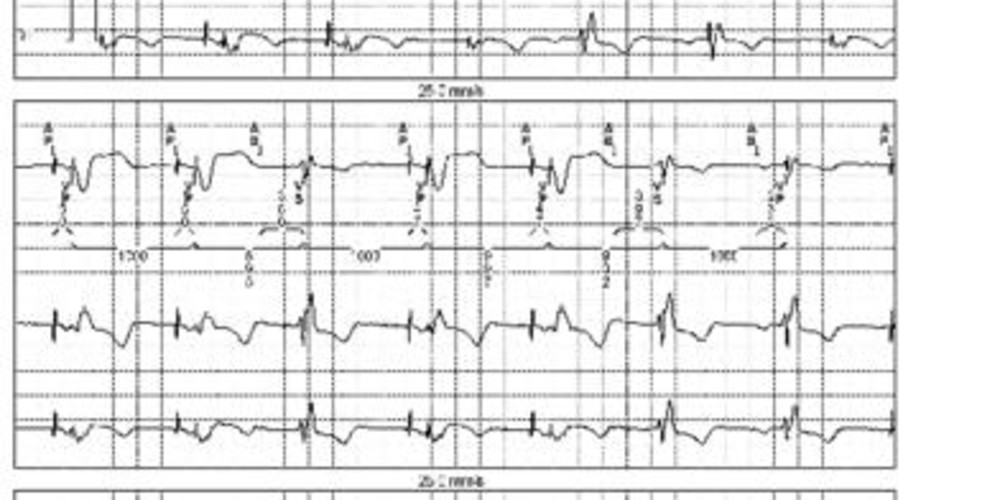Dual-chamber DDI mode
Tracing
Manufacturer Medtronic
Device PM
Field Pacing Modes
N° 7
Patient
Same patient as in tracing 1.

Graph and trace
Tracing 7a: programming in DDI mode 60 beats/minute;
- atrial and ventricular pacing at the base rate (AP-VP);
- acceleration of atrial spontaneous rhythm which is sensed (AS) and does not lead to AV delay; non-synchronized ventricular pacing on the atrium (pseudo-VVI) at the end of the ventricular pacing interval; inhibition of atrial pacing in the current cardiac cycle;
- atrial and ventricular spontaneous rhythm: inhibition of atrial pacing and of ventricular pacing;
- fusion with the ventricular spontaneous rhythm;
Tracing 7b: programming in DDI mode 70 beats/minute;
- permanent atrioventricular pacing (AP-VP); the spontaneous atrial rhythm is permanently "overdrived" by the atrial pacing; it should be noted that this atrial pacing with increased rate also allows suppressing atrial extrasystoles.
Other articles that may be of interest to you







The DDI mode provides dual-chamber, sequential AV pacing with atrial sensing but no tracking of the sensed atria. AV synchrony is only provided at the current atrial pacing rate (base rate pacing, rate responsive pacing or rate-smoothed pacing). If the atrium is faster than the atrial pacing rate, there is inhibition of atrial pacing and absence of AV delay; when the atria are spontaneous there is no ventricular synchrony.
Thus, in the case of AV block, spontaneous atria do not synchronize ventricular pacing if they are faster than the current atrial pacing rate: functioning is equivalent to VVI mode. This explains the absence of ventricular runaway pacing in the event of atrial arrhythmia sensing, hence the use of DDI as a fallback mode. It is also the function chosen when the pacemaker does not correctly sense atrial arrhythmias and therefore does not fallback properly, with erratic ventricular pacing. This choice is therefore not satisfactory in a patient with AV block and normal sinus function (no P-wave synchrony detected), but is conversely entirely acceptable if the patient also has a sinus dysfunction causing permanent atrial pacing even with permanent AV block (since atrial pacing synchronizes ventricular pacing). The setting of the base rate is therefore essential. It should be set high in order to avoid the occurrence of spontaneous atrial activation and be associated with rate responsive pacing. In this patient, programming at 70 beats per minute ensures satisfactory atrioventricular synchrony.
The ideal indication for this type of mode is a patient with AV block and atrial disease associating passage in fast AF (no risk of runaway) and permanent sinus dysfunction after reduction (AP-VP pacing).